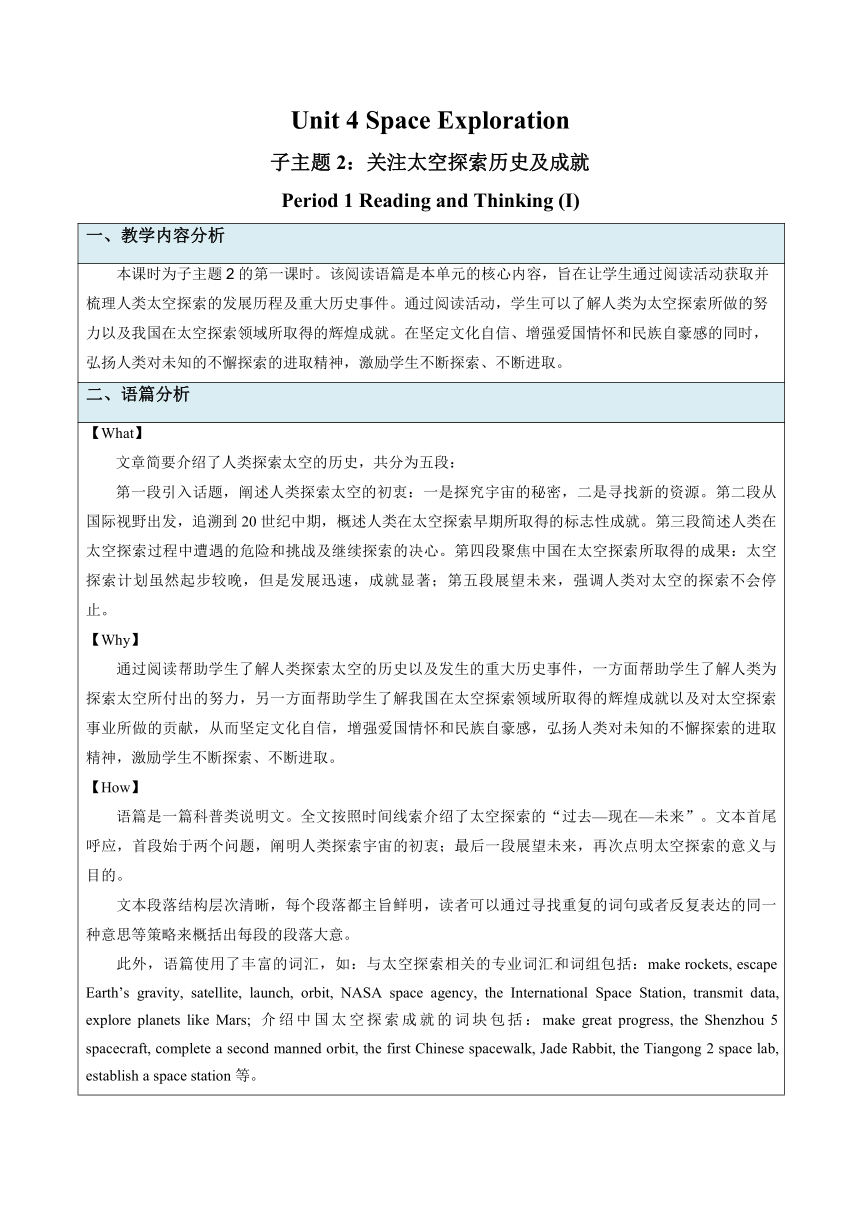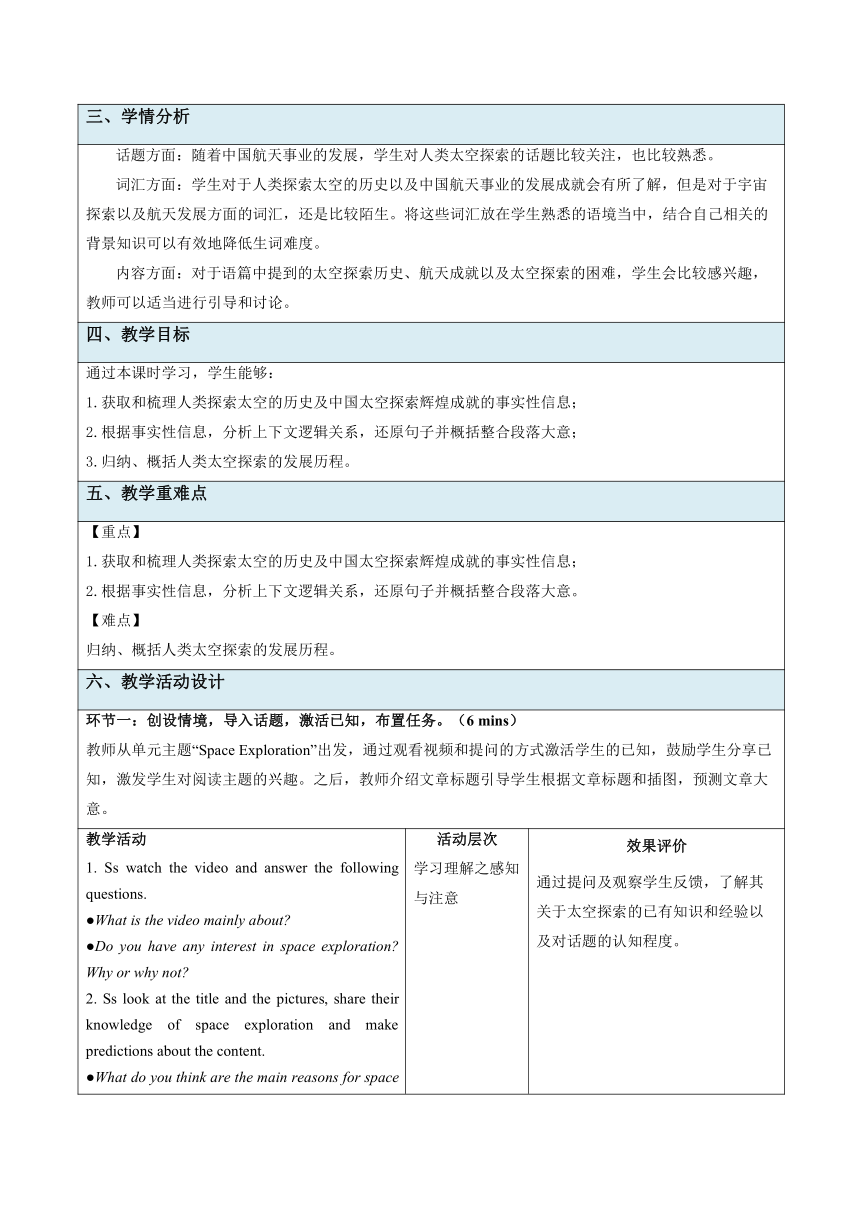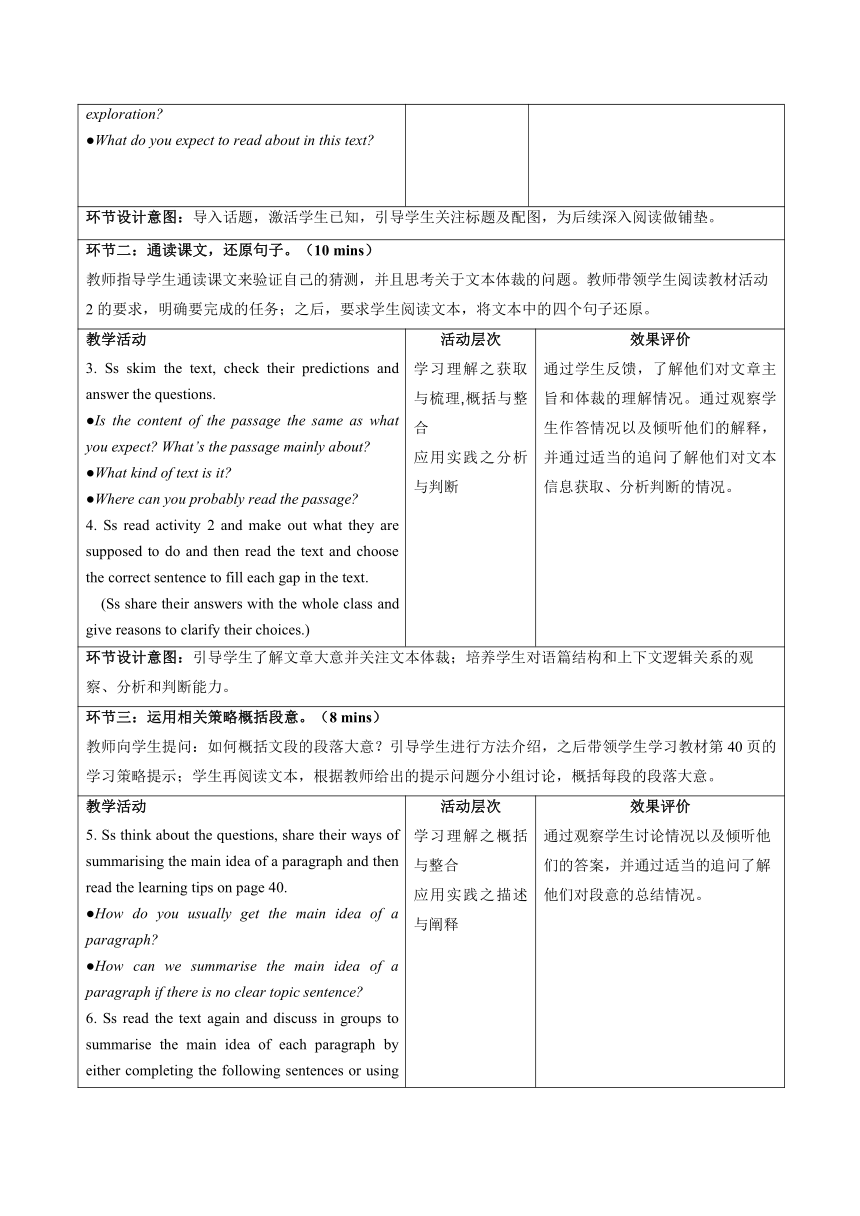人教版(2019)必修 第三册Unit 4 Space Exploration Reading and Thinking (I) 教案(表格式)
文档属性
| 名称 | 人教版(2019)必修 第三册Unit 4 Space Exploration Reading and Thinking (I) 教案(表格式) |

|
|
| 格式 | docx | ||
| 文件大小 | 40.9KB | ||
| 资源类型 | 教案 | ||
| 版本资源 | 人教版(2019) | ||
| 科目 | 英语 | ||
| 更新时间 | 2024-05-03 09:38:52 | ||
图片预览



文档简介
Unit 4 Space Exploration
子主题2:关注太空探索历史及成就
Period 1 Reading and Thinking (I)
一、教学内容分析
本课时为子主题2的第一课时。该阅读语篇是本单元的核心内容,旨在让学生通过阅读活动获取并梳理人类太空探索的发展历程及重大历史事件。通过阅读活动,学生可以了解人类为太空探索所做的努力以及我国在太空探索领域所取得的辉煌成就。在坚定文化自信、增强爱国情怀和民族自豪感的同时,弘扬人类对未知的不懈探索的进取精神,激励学生不断探索、不断进取。
二、语篇分析
【What】 文章简要介绍了人类探索太空的历史,共分为五段: 第一段引入话题,阐述人类探索太空的初衷:一是探究宇宙的秘密,二是寻找新的资源。第二段从国际视野出发,追溯到20世纪中期,概述人类在太空探索早期所取得的标志性成就。第三段简述人类在太空探索过程中遭遇的危险和挑战及继续探索的决心。第四段聚焦中国在太空探索所取得的成果:太空探索计划虽然起步较晚,但是发展迅速,成就显著;第五段展望未来,强调人类对太空的探索不会停止。 【Why】 通过阅读帮助学生了解人类探索太空的历史以及发生的重大历史事件,一方面帮助学生了解人类为探索太空所付出的努力,另一方面帮助学生了解我国在太空探索领域所取得的辉煌成就以及对太空探索事业所做的贡献,从而坚定文化自信,增强爱国情怀和民族自豪感,弘扬人类对未知的不懈探索的进取精神,激励学生不断探索、不断进取。 【How】 语篇是一篇科普类说明文。全文按照时间线索介绍了太空探索的“过去—现在—未来”。文本首尾呼应,首段始于两个问题,阐明人类探索宇宙的初衷;最后一段展望未来,再次点明太空探索的意义与目的。 文本段落结构层次清晰,每个段落都主旨鲜明,读者可以通过寻找重复的词句或者反复表达的同一种意思等策略来概括出每段的段落大意。 此外,语篇使用了丰富的词汇,如:与太空探索相关的专业词汇和词组包括:make rockets, escape Earth’s gravity, satellite, launch, orbit, NASA space agency, the International Space Station, transmit data, explore planets like Mars; 介绍中国太空探索成就的词块包括:make great progress, the Shenzhou 5 spacecraft, complete a second manned orbit, the first Chinese spacewalk, Jade Rabbit, the Tiangong 2 space lab, establish a space station等。
三、学情分析
话题方面:随着中国航天事业的发展,学生对人类太空探索的话题比较关注,也比较熟悉。 词汇方面:学生对于人类探索太空的历史以及中国航天事业的发展成就会有所了解,但是对于宇宙探索以及航天发展方面的词汇,还是比较陌生。将这些词汇放在学生熟悉的语境当中,结合自己相关的背景知识可以有效地降低生词难度。 内容方面:对于语篇中提到的太空探索历史、航天成就以及太空探索的困难,学生会比较感兴趣,教师可以适当进行引导和讨论。
四、教学目标
通过本课时学习,学生能够: 1.获取和梳理人类探索太空的历史及中国太空探索辉煌成就的事实性信息; 2.根据事实性信息,分析上下文逻辑关系,还原句子并概括整合段落大意; 3.归纳、概括人类太空探索的发展历程。
五、教学重难点
【重点】 1.获取和梳理人类探索太空的历史及中国太空探索辉煌成就的事实性信息; 2.根据事实性信息,分析上下文逻辑关系,还原句子并概括整合段落大意。 【难点】 归纳、概括人类太空探索的发展历程。
六、教学活动设计
环节一:创设情境,导入话题,激活已知,布置任务。(6 mins) 教师从单元主题“Space Exploration”出发,通过观看视频和提问的方式激活学生的已知,鼓励学生分享已知,激发学生对阅读主题的兴趣。之后,教师介绍文章标题引导学生根据文章标题和插图,预测文章大意。
教学活动 1. Ss watch the video and answer the following questions. ●What is the video mainly about ●Do you have any interest in space exploration Why or why not 2. Ss look at the title and the pictures, share their knowledge of space exploration and make predictions about the content. ●What do you think are the main reasons for space exploration ●What do you expect to read about in this text 活动层次 学习理解之感知与注意 效果评价 通过提问及观察学生反馈,了解其关于太空探索的已有知识和经验以及对话题的认知程度。
环节设计意图:导入话题,激活学生已知,引导学生关注标题及配图,为后续深入阅读做铺垫。
环节二:通读课文,还原句子。(10 mins) 教师指导学生通读课文来验证自己的猜测,并且思考关于文本体裁的问题。教师带领学生阅读教材活动2的要求,明确要完成的任务;之后,要求学生阅读文本,将文本中的四个句子还原。
教学活动 3. Ss skim the text, check their predictions and answer the questions. ●Is the content of the passage the same as what you expect What’s the passage mainly about ●What kind of text is it ●Where can you probably read the passage 4. Ss read activity 2 and make out what they are supposed to do and then read the text and choose the correct sentence to fill each gap in the text. (Ss share their answers with the whole class and give reasons to clarify their choices.) 活动层次 学习理解之获取与梳理,概括与整合 应用实践之分析与判断 效果评价 通过学生反馈,了解他们对文章主旨和体裁的理解情况。通过观察学生作答情况以及倾听他们的解释,并通过适当的追问了解他们对文本信息获取、分析判断的情况。
环节设计意图:引导学生了解文章大意并关注文本体裁;培养学生对语篇结构和上下文逻辑关系的观察、分析和判断能力。
环节三:运用相关策略概括段意。(8 mins) 教师向学生提问:如何概括文段的段落大意?引导学生进行方法介绍,之后带领学生学习教材第40页的学习策略提示;学生再阅读文本,根据教师给出的提示问题分小组讨论,概括每段的段落大意。
教学活动 5. Ss think about the questions, share their ways of summarising the main idea of a paragraph and then read the learning tips on page 40. ●How do you usually get the main idea of a paragraph ●How can we summarise the main idea of a paragraph if there is no clear topic sentence 6. Ss read the text again and discuss in groups to summarise the main idea of each paragraph by either completing the following sentences or using their own words. Paragraph 1: People are _________ and scientists ________________________________________. Paragraph 2: In the 20th century, ______________ ________________________________________. Paragraph 3: Humans _____________ in spite of ________________________________________. Paragraph 4: China’s space programme ________ ________________________________________. Paragraph 5: The future of space exploration ____ ________________________________________. 活动层次 学习理解之概括与整合 应用实践之描述与阐释 效果评价 通过观察学生讨论情况以及倾听他们的答案,并通过适当的追问了解他们对段意的总结情况。
环节设计意图:培养学生根据关键信息和主题句概括段意的能力。
环节四:获取和梳理信息。(10 mins) 教师提出问题,引导学生重点阅读文本第二段和第四段,梳理人类探索太空的活动及中国太空探索辉煌成就的相关信息。学生通过阅读获取和梳理信息,然后与同伴交流,补充完善信息。
教学活动 7. Ss sort out information about the history and achievements in space exploration according to the questions. ●What are the achievements that humans made to explore space in the 20th century ●What are the achievements that China has made in space exploration (Ss share with the whole class.) 8. Ss work in pairs. One introduces the history and achievements in space exploration abroad and the other introduces those of China. They can add information to their own work if necessary. 活动层次 学习理解之获取与梳理 应用实践之内化与运用 效果评价 通过观察学生的信息梳理以及课堂讨论,把握他们获取主要信息的情况。
环节设计意图:在问题引领下帮助学生梳理人类探索探空的活动和成就。
环节五:基于语篇理解,完成语段填空及填词游戏。(6 mins) 教师引导学生阅读教材活动5的语段并理解大意:虽然人类在太空探索中会面临种种危险,但人类从未放弃探索。学生基于对阅读语篇的理解,运用语篇中的新词汇来补全语段及完成填词游戏。
教学活动 9. Ss read the paragraph to get the main idea of it, complete the passage with the words from the text and then share the answers with the whole class. 10. Ss read the definitions, think of words to fit for the definitions and complete the crossword. 活动层次 应用实践之内化与运用 效果评价 通过观察学生作答情况以及倾听他们的答案,了解他们对新词汇及语段的理解情况。
环节设计意图:帮助学生巩固和内化文本中的新词汇,在理解的基础上学会迁移运用。
作业与拓展学习设计 1. Read the text again and sort out the information about human’s achievements in space exploration according to the timeline. 2. Search the Internet for information about China’s achievements in space exploration.
Worksheet
Unit 4 Reading and Thinking (I)
Activity 1: Watch and answer
Watch the video and answer the following questions.
1. What is the video mainly about
2. Do you have any interest in space exploration Why or why not
Activity 2: Look and predict
Look at the title and the pictures and then answer the questions.
1. What do you think are the main reasons for space exploration
2. What do you expect to read about in this text
Activity 3: Skim, check and answer
1. Is the content of the passage the same as what you expect What’s the passage mainly about
2. What kind of text is it
3. Where can you probably read the passage
Activity 4: Read and choose
Read the text. Several sentences have been removed from it. Choose the correct sentence (A-D) to fill each gap.
Activity 5: Think and discuss the following questions
1. How do you usually get the main idea of a paragraph
2. How can we summarise the main idea of a paragraph if there is no clear topic sentence
Activity 6: Summarise the main idea
Work in groups to summarise the main idea of each paragraph by either completing the following sentences or using your own words.
Paragraph 1: People are _____________________ and scientists __________________________.
Paragraph 2: In the 20th century, ____________________________________________________.
Paragraph 3: Humans ________________________________ in spite of ___________________.
Paragraph 4: China’s space programme ______________________________________________.
Paragraph 5: The future of space exploration__________________________________________.
Activity 7: Read and sort out information
Read the passage again and sort out information according to the questions.
1. What are the achievements that humans made to explore space in the 20th century
2. What are the achievements that China has made in space exploration
Activity 8: Work in pairs and introduce
Introduce the history and achievements both abroad and China in space exploration.
Activity 9: Read and complete
Complete the passage with words from the text.
Activity 10: Think and complete
Think of a word that best fits each definition and complete the crossword.
Homework
1. Read the text again and sort out the information about human’s achievements in space exploration according to the timeline.
2. Search the Internet for information about China’s achievements in space exploration.
子主题2:关注太空探索历史及成就
Period 1 Reading and Thinking (I)
一、教学内容分析
本课时为子主题2的第一课时。该阅读语篇是本单元的核心内容,旨在让学生通过阅读活动获取并梳理人类太空探索的发展历程及重大历史事件。通过阅读活动,学生可以了解人类为太空探索所做的努力以及我国在太空探索领域所取得的辉煌成就。在坚定文化自信、增强爱国情怀和民族自豪感的同时,弘扬人类对未知的不懈探索的进取精神,激励学生不断探索、不断进取。
二、语篇分析
【What】 文章简要介绍了人类探索太空的历史,共分为五段: 第一段引入话题,阐述人类探索太空的初衷:一是探究宇宙的秘密,二是寻找新的资源。第二段从国际视野出发,追溯到20世纪中期,概述人类在太空探索早期所取得的标志性成就。第三段简述人类在太空探索过程中遭遇的危险和挑战及继续探索的决心。第四段聚焦中国在太空探索所取得的成果:太空探索计划虽然起步较晚,但是发展迅速,成就显著;第五段展望未来,强调人类对太空的探索不会停止。 【Why】 通过阅读帮助学生了解人类探索太空的历史以及发生的重大历史事件,一方面帮助学生了解人类为探索太空所付出的努力,另一方面帮助学生了解我国在太空探索领域所取得的辉煌成就以及对太空探索事业所做的贡献,从而坚定文化自信,增强爱国情怀和民族自豪感,弘扬人类对未知的不懈探索的进取精神,激励学生不断探索、不断进取。 【How】 语篇是一篇科普类说明文。全文按照时间线索介绍了太空探索的“过去—现在—未来”。文本首尾呼应,首段始于两个问题,阐明人类探索宇宙的初衷;最后一段展望未来,再次点明太空探索的意义与目的。 文本段落结构层次清晰,每个段落都主旨鲜明,读者可以通过寻找重复的词句或者反复表达的同一种意思等策略来概括出每段的段落大意。 此外,语篇使用了丰富的词汇,如:与太空探索相关的专业词汇和词组包括:make rockets, escape Earth’s gravity, satellite, launch, orbit, NASA space agency, the International Space Station, transmit data, explore planets like Mars; 介绍中国太空探索成就的词块包括:make great progress, the Shenzhou 5 spacecraft, complete a second manned orbit, the first Chinese spacewalk, Jade Rabbit, the Tiangong 2 space lab, establish a space station等。
三、学情分析
话题方面:随着中国航天事业的发展,学生对人类太空探索的话题比较关注,也比较熟悉。 词汇方面:学生对于人类探索太空的历史以及中国航天事业的发展成就会有所了解,但是对于宇宙探索以及航天发展方面的词汇,还是比较陌生。将这些词汇放在学生熟悉的语境当中,结合自己相关的背景知识可以有效地降低生词难度。 内容方面:对于语篇中提到的太空探索历史、航天成就以及太空探索的困难,学生会比较感兴趣,教师可以适当进行引导和讨论。
四、教学目标
通过本课时学习,学生能够: 1.获取和梳理人类探索太空的历史及中国太空探索辉煌成就的事实性信息; 2.根据事实性信息,分析上下文逻辑关系,还原句子并概括整合段落大意; 3.归纳、概括人类太空探索的发展历程。
五、教学重难点
【重点】 1.获取和梳理人类探索太空的历史及中国太空探索辉煌成就的事实性信息; 2.根据事实性信息,分析上下文逻辑关系,还原句子并概括整合段落大意。 【难点】 归纳、概括人类太空探索的发展历程。
六、教学活动设计
环节一:创设情境,导入话题,激活已知,布置任务。(6 mins) 教师从单元主题“Space Exploration”出发,通过观看视频和提问的方式激活学生的已知,鼓励学生分享已知,激发学生对阅读主题的兴趣。之后,教师介绍文章标题引导学生根据文章标题和插图,预测文章大意。
教学活动 1. Ss watch the video and answer the following questions. ●What is the video mainly about ●Do you have any interest in space exploration Why or why not 2. Ss look at the title and the pictures, share their knowledge of space exploration and make predictions about the content. ●What do you think are the main reasons for space exploration ●What do you expect to read about in this text 活动层次 学习理解之感知与注意 效果评价 通过提问及观察学生反馈,了解其关于太空探索的已有知识和经验以及对话题的认知程度。
环节设计意图:导入话题,激活学生已知,引导学生关注标题及配图,为后续深入阅读做铺垫。
环节二:通读课文,还原句子。(10 mins) 教师指导学生通读课文来验证自己的猜测,并且思考关于文本体裁的问题。教师带领学生阅读教材活动2的要求,明确要完成的任务;之后,要求学生阅读文本,将文本中的四个句子还原。
教学活动 3. Ss skim the text, check their predictions and answer the questions. ●Is the content of the passage the same as what you expect What’s the passage mainly about ●What kind of text is it ●Where can you probably read the passage 4. Ss read activity 2 and make out what they are supposed to do and then read the text and choose the correct sentence to fill each gap in the text. (Ss share their answers with the whole class and give reasons to clarify their choices.) 活动层次 学习理解之获取与梳理,概括与整合 应用实践之分析与判断 效果评价 通过学生反馈,了解他们对文章主旨和体裁的理解情况。通过观察学生作答情况以及倾听他们的解释,并通过适当的追问了解他们对文本信息获取、分析判断的情况。
环节设计意图:引导学生了解文章大意并关注文本体裁;培养学生对语篇结构和上下文逻辑关系的观察、分析和判断能力。
环节三:运用相关策略概括段意。(8 mins) 教师向学生提问:如何概括文段的段落大意?引导学生进行方法介绍,之后带领学生学习教材第40页的学习策略提示;学生再阅读文本,根据教师给出的提示问题分小组讨论,概括每段的段落大意。
教学活动 5. Ss think about the questions, share their ways of summarising the main idea of a paragraph and then read the learning tips on page 40. ●How do you usually get the main idea of a paragraph ●How can we summarise the main idea of a paragraph if there is no clear topic sentence 6. Ss read the text again and discuss in groups to summarise the main idea of each paragraph by either completing the following sentences or using their own words. Paragraph 1: People are _________ and scientists ________________________________________. Paragraph 2: In the 20th century, ______________ ________________________________________. Paragraph 3: Humans _____________ in spite of ________________________________________. Paragraph 4: China’s space programme ________ ________________________________________. Paragraph 5: The future of space exploration ____ ________________________________________. 活动层次 学习理解之概括与整合 应用实践之描述与阐释 效果评价 通过观察学生讨论情况以及倾听他们的答案,并通过适当的追问了解他们对段意的总结情况。
环节设计意图:培养学生根据关键信息和主题句概括段意的能力。
环节四:获取和梳理信息。(10 mins) 教师提出问题,引导学生重点阅读文本第二段和第四段,梳理人类探索太空的活动及中国太空探索辉煌成就的相关信息。学生通过阅读获取和梳理信息,然后与同伴交流,补充完善信息。
教学活动 7. Ss sort out information about the history and achievements in space exploration according to the questions. ●What are the achievements that humans made to explore space in the 20th century ●What are the achievements that China has made in space exploration (Ss share with the whole class.) 8. Ss work in pairs. One introduces the history and achievements in space exploration abroad and the other introduces those of China. They can add information to their own work if necessary. 活动层次 学习理解之获取与梳理 应用实践之内化与运用 效果评价 通过观察学生的信息梳理以及课堂讨论,把握他们获取主要信息的情况。
环节设计意图:在问题引领下帮助学生梳理人类探索探空的活动和成就。
环节五:基于语篇理解,完成语段填空及填词游戏。(6 mins) 教师引导学生阅读教材活动5的语段并理解大意:虽然人类在太空探索中会面临种种危险,但人类从未放弃探索。学生基于对阅读语篇的理解,运用语篇中的新词汇来补全语段及完成填词游戏。
教学活动 9. Ss read the paragraph to get the main idea of it, complete the passage with the words from the text and then share the answers with the whole class. 10. Ss read the definitions, think of words to fit for the definitions and complete the crossword. 活动层次 应用实践之内化与运用 效果评价 通过观察学生作答情况以及倾听他们的答案,了解他们对新词汇及语段的理解情况。
环节设计意图:帮助学生巩固和内化文本中的新词汇,在理解的基础上学会迁移运用。
作业与拓展学习设计 1. Read the text again and sort out the information about human’s achievements in space exploration according to the timeline. 2. Search the Internet for information about China’s achievements in space exploration.
Worksheet
Unit 4 Reading and Thinking (I)
Activity 1: Watch and answer
Watch the video and answer the following questions.
1. What is the video mainly about
2. Do you have any interest in space exploration Why or why not
Activity 2: Look and predict
Look at the title and the pictures and then answer the questions.
1. What do you think are the main reasons for space exploration
2. What do you expect to read about in this text
Activity 3: Skim, check and answer
1. Is the content of the passage the same as what you expect What’s the passage mainly about
2. What kind of text is it
3. Where can you probably read the passage
Activity 4: Read and choose
Read the text. Several sentences have been removed from it. Choose the correct sentence (A-D) to fill each gap.
Activity 5: Think and discuss the following questions
1. How do you usually get the main idea of a paragraph
2. How can we summarise the main idea of a paragraph if there is no clear topic sentence
Activity 6: Summarise the main idea
Work in groups to summarise the main idea of each paragraph by either completing the following sentences or using your own words.
Paragraph 1: People are _____________________ and scientists __________________________.
Paragraph 2: In the 20th century, ____________________________________________________.
Paragraph 3: Humans ________________________________ in spite of ___________________.
Paragraph 4: China’s space programme ______________________________________________.
Paragraph 5: The future of space exploration__________________________________________.
Activity 7: Read and sort out information
Read the passage again and sort out information according to the questions.
1. What are the achievements that humans made to explore space in the 20th century
2. What are the achievements that China has made in space exploration
Activity 8: Work in pairs and introduce
Introduce the history and achievements both abroad and China in space exploration.
Activity 9: Read and complete
Complete the passage with words from the text.
Activity 10: Think and complete
Think of a word that best fits each definition and complete the crossword.
Homework
1. Read the text again and sort out the information about human’s achievements in space exploration according to the timeline.
2. Search the Internet for information about China’s achievements in space exploration.
